Entrepreneurship & Small Business: Venture Types and Impact Assessment
VerifiedAdded on 2020/10/22
|22
|4237
|171
Essay
AI Summary
This essay provides a detailed analysis of entrepreneurship and small business management. It begins by defining entrepreneurship and categorizing entrepreneurial ventures into small profit, lifestyle, and high growth ventures. It further classifies entrepreneurs based on business type, technology use, ownership, gender, and enterprise size. The essay explores the similarities and differences between various venture types, focusing on decision-making processes, organizational management, customer base, and challenges faced. It assesses the impact of micro and small businesses on the economy, highlighting their role in job creation, GDP contribution, diversification, and foreign trade. The importance of small businesses and start-ups in developing the social economy is also examined, emphasizing competition, local hiring, and workplace diversity. Finally, the essay identifies the characteristics, skills, and traits of successful entrepreneurs, linking entrepreneurial personality to mindset and motivation, and exploring the relationship between past experiences and entrepreneurial pursuits.

ENTREPRENEURSHIP AND SMALL BUSINESS
MANAGEMENT
1
MANAGEMENT
1
Paraphrase This Document
Need a fresh take? Get an instant paraphrase of this document with our AI Paraphraser
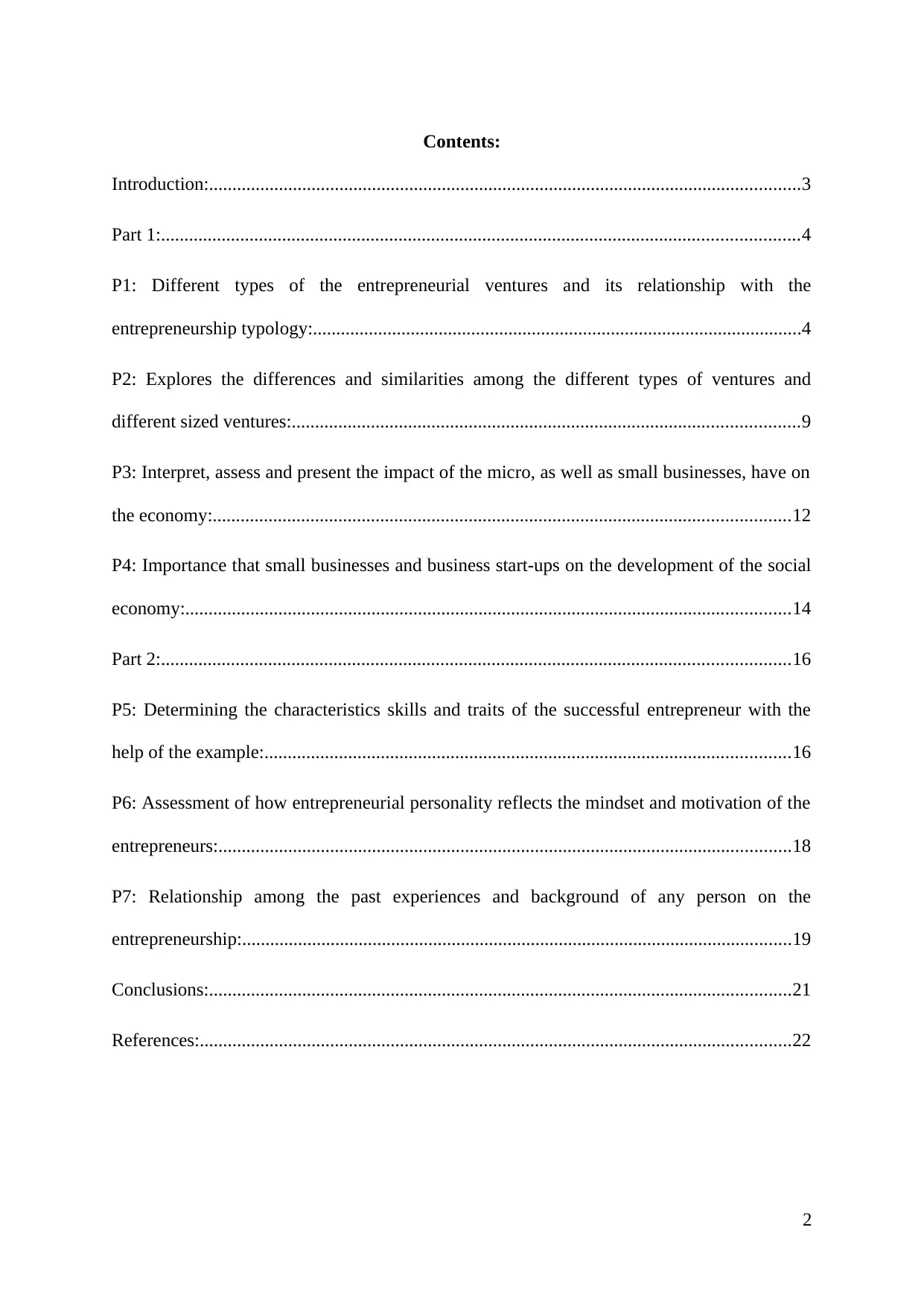
Contents:
Introduction:...............................................................................................................................3
Part 1:.........................................................................................................................................4
P1: Different types of the entrepreneurial ventures and its relationship with the
entrepreneurship typology:.........................................................................................................4
P2: Explores the differences and similarities among the different types of ventures and
different sized ventures:.............................................................................................................9
P3: Interpret, assess and present the impact of the micro, as well as small businesses, have on
the economy:............................................................................................................................12
P4: Importance that small businesses and business start-ups on the development of the social
economy:..................................................................................................................................14
Part 2:.......................................................................................................................................16
P5: Determining the characteristics skills and traits of the successful entrepreneur with the
help of the example:.................................................................................................................16
P6: Assessment of how entrepreneurial personality reflects the mindset and motivation of the
entrepreneurs:...........................................................................................................................18
P7: Relationship among the past experiences and background of any person on the
entrepreneurship:......................................................................................................................19
Conclusions:.............................................................................................................................21
References:...............................................................................................................................22
2
Introduction:...............................................................................................................................3
Part 1:.........................................................................................................................................4
P1: Different types of the entrepreneurial ventures and its relationship with the
entrepreneurship typology:.........................................................................................................4
P2: Explores the differences and similarities among the different types of ventures and
different sized ventures:.............................................................................................................9
P3: Interpret, assess and present the impact of the micro, as well as small businesses, have on
the economy:............................................................................................................................12
P4: Importance that small businesses and business start-ups on the development of the social
economy:..................................................................................................................................14
Part 2:.......................................................................................................................................16
P5: Determining the characteristics skills and traits of the successful entrepreneur with the
help of the example:.................................................................................................................16
P6: Assessment of how entrepreneurial personality reflects the mindset and motivation of the
entrepreneurs:...........................................................................................................................18
P7: Relationship among the past experiences and background of any person on the
entrepreneurship:......................................................................................................................19
Conclusions:.............................................................................................................................21
References:...............................................................................................................................22
2

Introduction:
The world economy is developing at a steady rate. There is always a demand for goods in the
market. The market is becoming large. With the developing economy and with the ever-
increasing needs of the customers, many individuals are taking up small businesses. This is
known as entrepreneurship. The individual takes up small businesses mainly to earn profits.
This entrepreneurship is becoming important. In the following essay, we see the various
kinds of entrepreneurial ventures and types of entrepreneurs. This essay brings out the
various aspects of entrepreneurship along with bringing out the characteristics required to be
a successful entrepreneur.
3
The world economy is developing at a steady rate. There is always a demand for goods in the
market. The market is becoming large. With the developing economy and with the ever-
increasing needs of the customers, many individuals are taking up small businesses. This is
known as entrepreneurship. The individual takes up small businesses mainly to earn profits.
This entrepreneurship is becoming important. In the following essay, we see the various
kinds of entrepreneurial ventures and types of entrepreneurs. This essay brings out the
various aspects of entrepreneurship along with bringing out the characteristics required to be
a successful entrepreneur.
3
⊘ This is a preview!⊘
Do you want full access?
Subscribe today to unlock all pages.

Trusted by 1+ million students worldwide

Other
businesses
Small business
owners
Entrepreneurs
Entrepreneurial small
business owners
Part 1:
P1: Different types of the entrepreneurial ventures and its relationship with the
entrepreneurship typology:
Entrepreneurship is mainly defined as the way in which a person develops a small business to
earn profits by taking significant risks. As stated by Ibrahim (2014), it is where the person has
the objective and mindset to have a business of his own. He is ready to take risks and
challenges shortly and as such the risks small or large amounts of money with the goal to
earn maximum profit. Entrepreneurship helps businesses to grow. Entrepreneurship provides
the scope for small businesses men to earn profits as they take ventures. It also helps in the
overall growth of a person and makes the person responsible for doing any job. As opined by
DeNisi (2015),an entrepreneur is ready for any challenges which may arise in business. As
such entrepreneurial ventures are mainly categorised into three types- small profit ventures,
lifestyle ventures and high growth ventures.
Figure: Concept of Entrepreneurship Venture
(Source: Shaikh, 2016)
4
businesses
Small business
owners
Entrepreneurs
Entrepreneurial small
business owners
Part 1:
P1: Different types of the entrepreneurial ventures and its relationship with the
entrepreneurship typology:
Entrepreneurship is mainly defined as the way in which a person develops a small business to
earn profits by taking significant risks. As stated by Ibrahim (2014), it is where the person has
the objective and mindset to have a business of his own. He is ready to take risks and
challenges shortly and as such the risks small or large amounts of money with the goal to
earn maximum profit. Entrepreneurship helps businesses to grow. Entrepreneurship provides
the scope for small businesses men to earn profits as they take ventures. It also helps in the
overall growth of a person and makes the person responsible for doing any job. As opined by
DeNisi (2015),an entrepreneur is ready for any challenges which may arise in business. As
such entrepreneurial ventures are mainly categorised into three types- small profit ventures,
lifestyle ventures and high growth ventures.
Figure: Concept of Entrepreneurship Venture
(Source: Shaikh, 2016)
4
Paraphrase This Document
Need a fresh take? Get an instant paraphrase of this document with our AI Paraphraser
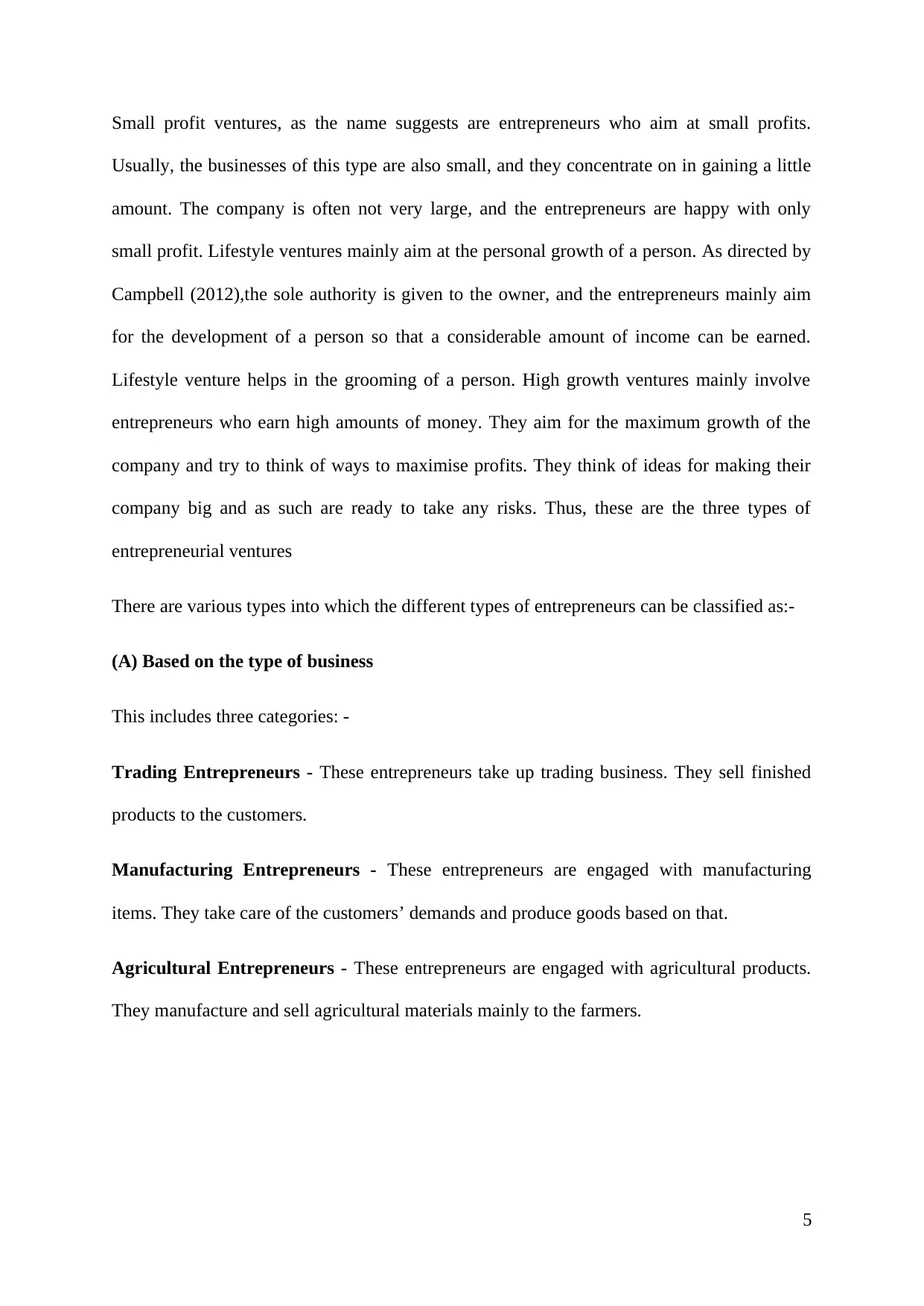
Small profit ventures, as the name suggests are entrepreneurs who aim at small profits.
Usually, the businesses of this type are also small, and they concentrate on in gaining a little
amount. The company is often not very large, and the entrepreneurs are happy with only
small profit. Lifestyle ventures mainly aim at the personal growth of a person. As directed by
Campbell (2012),the sole authority is given to the owner, and the entrepreneurs mainly aim
for the development of a person so that a considerable amount of income can be earned.
Lifestyle venture helps in the grooming of a person. High growth ventures mainly involve
entrepreneurs who earn high amounts of money. They aim for the maximum growth of the
company and try to think of ways to maximise profits. They think of ideas for making their
company big and as such are ready to take any risks. Thus, these are the three types of
entrepreneurial ventures
There are various types into which the different types of entrepreneurs can be classified as:-
(A) Based on the type of business
This includes three categories: -
Trading Entrepreneurs - These entrepreneurs take up trading business. They sell finished
products to the customers.
Manufacturing Entrepreneurs - These entrepreneurs are engaged with manufacturing
items. They take care of the customers’ demands and produce goods based on that.
Agricultural Entrepreneurs - These entrepreneurs are engaged with agricultural products.
They manufacture and sell agricultural materials mainly to the farmers.
5
Usually, the businesses of this type are also small, and they concentrate on in gaining a little
amount. The company is often not very large, and the entrepreneurs are happy with only
small profit. Lifestyle ventures mainly aim at the personal growth of a person. As directed by
Campbell (2012),the sole authority is given to the owner, and the entrepreneurs mainly aim
for the development of a person so that a considerable amount of income can be earned.
Lifestyle venture helps in the grooming of a person. High growth ventures mainly involve
entrepreneurs who earn high amounts of money. They aim for the maximum growth of the
company and try to think of ways to maximise profits. They think of ideas for making their
company big and as such are ready to take any risks. Thus, these are the three types of
entrepreneurial ventures
There are various types into which the different types of entrepreneurs can be classified as:-
(A) Based on the type of business
This includes three categories: -
Trading Entrepreneurs - These entrepreneurs take up trading business. They sell finished
products to the customers.
Manufacturing Entrepreneurs - These entrepreneurs are engaged with manufacturing
items. They take care of the customers’ demands and produce goods based on that.
Agricultural Entrepreneurs - These entrepreneurs are engaged with agricultural products.
They manufacture and sell agricultural materials mainly to the farmers.
5
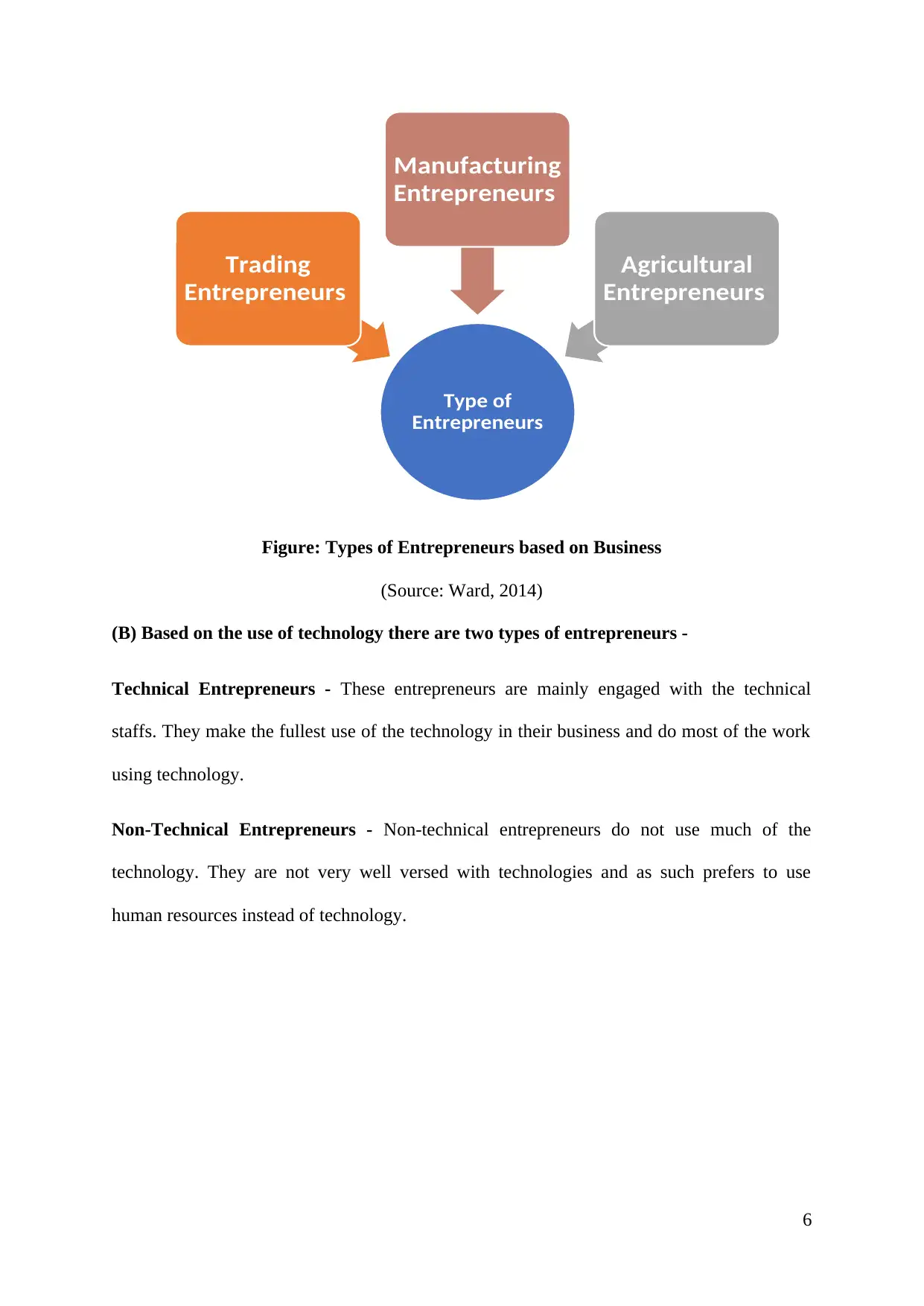
Figure: Types of Entrepreneurs based on Business
(Source: Ward, 2014)
(B) Based on the use of technology there are two types of entrepreneurs -
Technical Entrepreneurs - These entrepreneurs are mainly engaged with the technical
staffs. They make the fullest use of the technology in their business and do most of the work
using technology.
Non-Technical Entrepreneurs - Non-technical entrepreneurs do not use much of the
technology. They are not very well versed with technologies and as such prefers to use
human resources instead of technology.
6
Type of
Entrepreneurs
Trading
Entrepreneurs
Manufacturing
Entrepreneurs
Agricultural
Entrepreneurs
(Source: Ward, 2014)
(B) Based on the use of technology there are two types of entrepreneurs -
Technical Entrepreneurs - These entrepreneurs are mainly engaged with the technical
staffs. They make the fullest use of the technology in their business and do most of the work
using technology.
Non-Technical Entrepreneurs - Non-technical entrepreneurs do not use much of the
technology. They are not very well versed with technologies and as such prefers to use
human resources instead of technology.
6
Type of
Entrepreneurs
Trading
Entrepreneurs
Manufacturing
Entrepreneurs
Agricultural
Entrepreneurs
⊘ This is a preview!⊘
Do you want full access?
Subscribe today to unlock all pages.

Trusted by 1+ million students worldwide
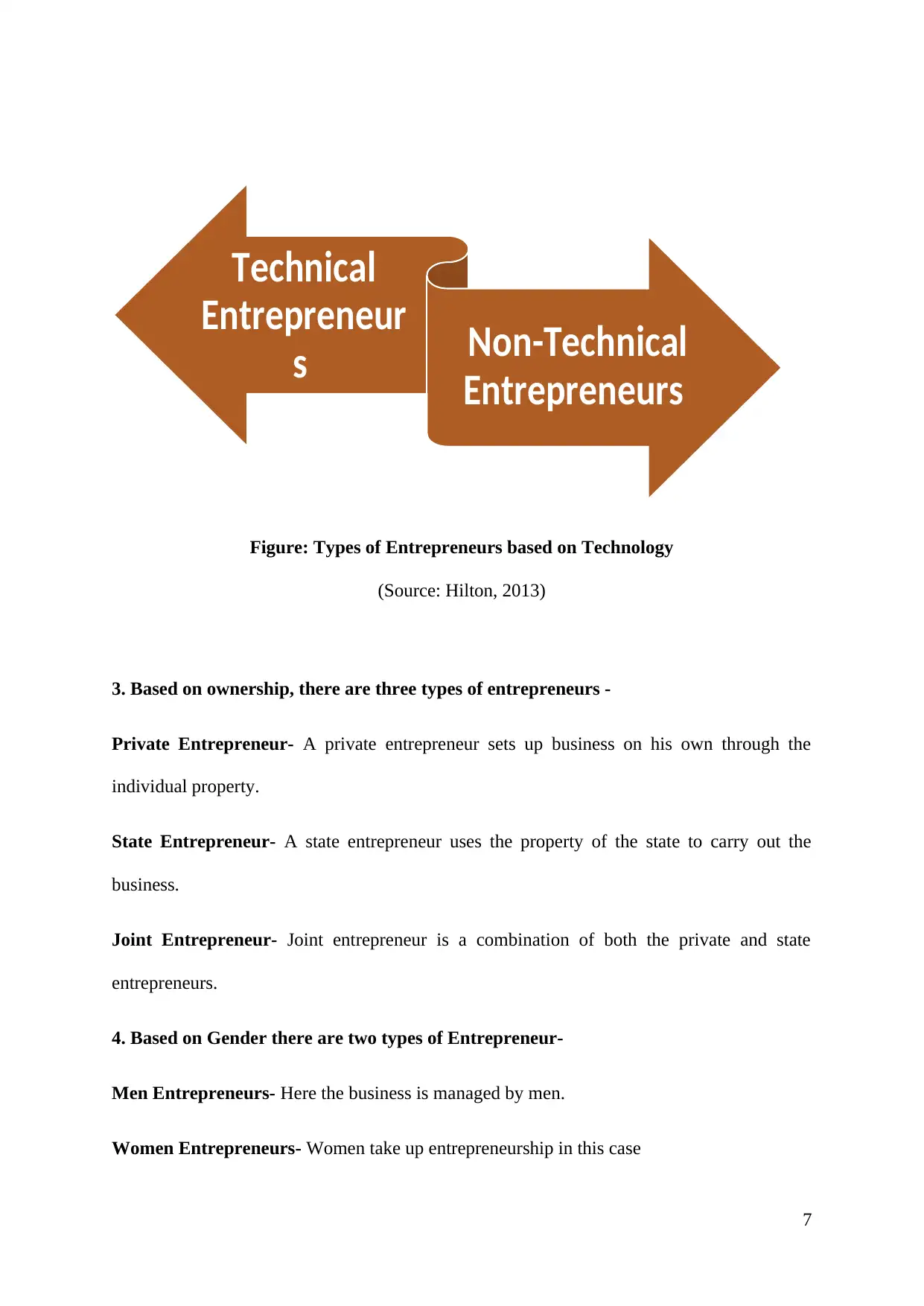
Figure: Types of Entrepreneurs based on Technology
(Source: Hilton, 2013)
3. Based on ownership, there are three types of entrepreneurs -
Private Entrepreneur- A private entrepreneur sets up business on his own through the
individual property.
State Entrepreneur- A state entrepreneur uses the property of the state to carry out the
business.
Joint Entrepreneur- Joint entrepreneur is a combination of both the private and state
entrepreneurs.
4. Based on Gender there are two types of Entrepreneur-
Men Entrepreneurs- Here the business is managed by men.
Women Entrepreneurs- Women take up entrepreneurship in this case
7
Technical
Entrepreneur
s Non-Technical
Entrepreneurs
(Source: Hilton, 2013)
3. Based on ownership, there are three types of entrepreneurs -
Private Entrepreneur- A private entrepreneur sets up business on his own through the
individual property.
State Entrepreneur- A state entrepreneur uses the property of the state to carry out the
business.
Joint Entrepreneur- Joint entrepreneur is a combination of both the private and state
entrepreneurs.
4. Based on Gender there are two types of Entrepreneur-
Men Entrepreneurs- Here the business is managed by men.
Women Entrepreneurs- Women take up entrepreneurship in this case
7
Technical
Entrepreneur
s Non-Technical
Entrepreneurs
Paraphrase This Document
Need a fresh take? Get an instant paraphrase of this document with our AI Paraphraser
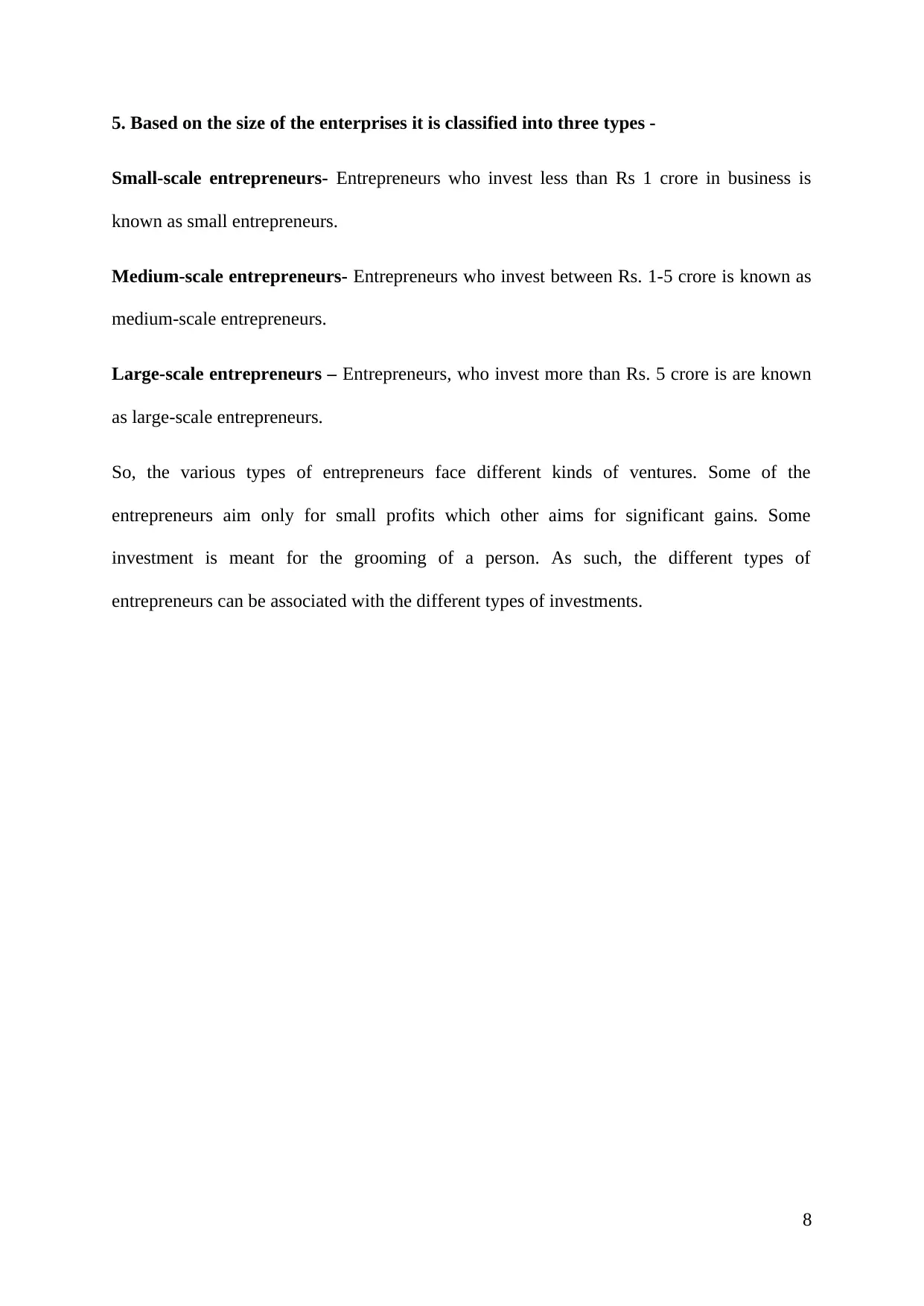
5. Based on the size of the enterprises it is classified into three types -
Small-scale entrepreneurs- Entrepreneurs who invest less than Rs 1 crore in business is
known as small entrepreneurs.
Medium-scale entrepreneurs- Entrepreneurs who invest between Rs. 1-5 crore is known as
medium-scale entrepreneurs.
Large-scale entrepreneurs – Entrepreneurs, who invest more than Rs. 5 crore is are known
as large-scale entrepreneurs.
So, the various types of entrepreneurs face different kinds of ventures. Some of the
entrepreneurs aim only for small profits which other aims for significant gains. Some
investment is meant for the grooming of a person. As such, the different types of
entrepreneurs can be associated with the different types of investments.
8
Small-scale entrepreneurs- Entrepreneurs who invest less than Rs 1 crore in business is
known as small entrepreneurs.
Medium-scale entrepreneurs- Entrepreneurs who invest between Rs. 1-5 crore is known as
medium-scale entrepreneurs.
Large-scale entrepreneurs – Entrepreneurs, who invest more than Rs. 5 crore is are known
as large-scale entrepreneurs.
So, the various types of entrepreneurs face different kinds of ventures. Some of the
entrepreneurs aim only for small profits which other aims for significant gains. Some
investment is meant for the grooming of a person. As such, the different types of
entrepreneurs can be associated with the different types of investments.
8
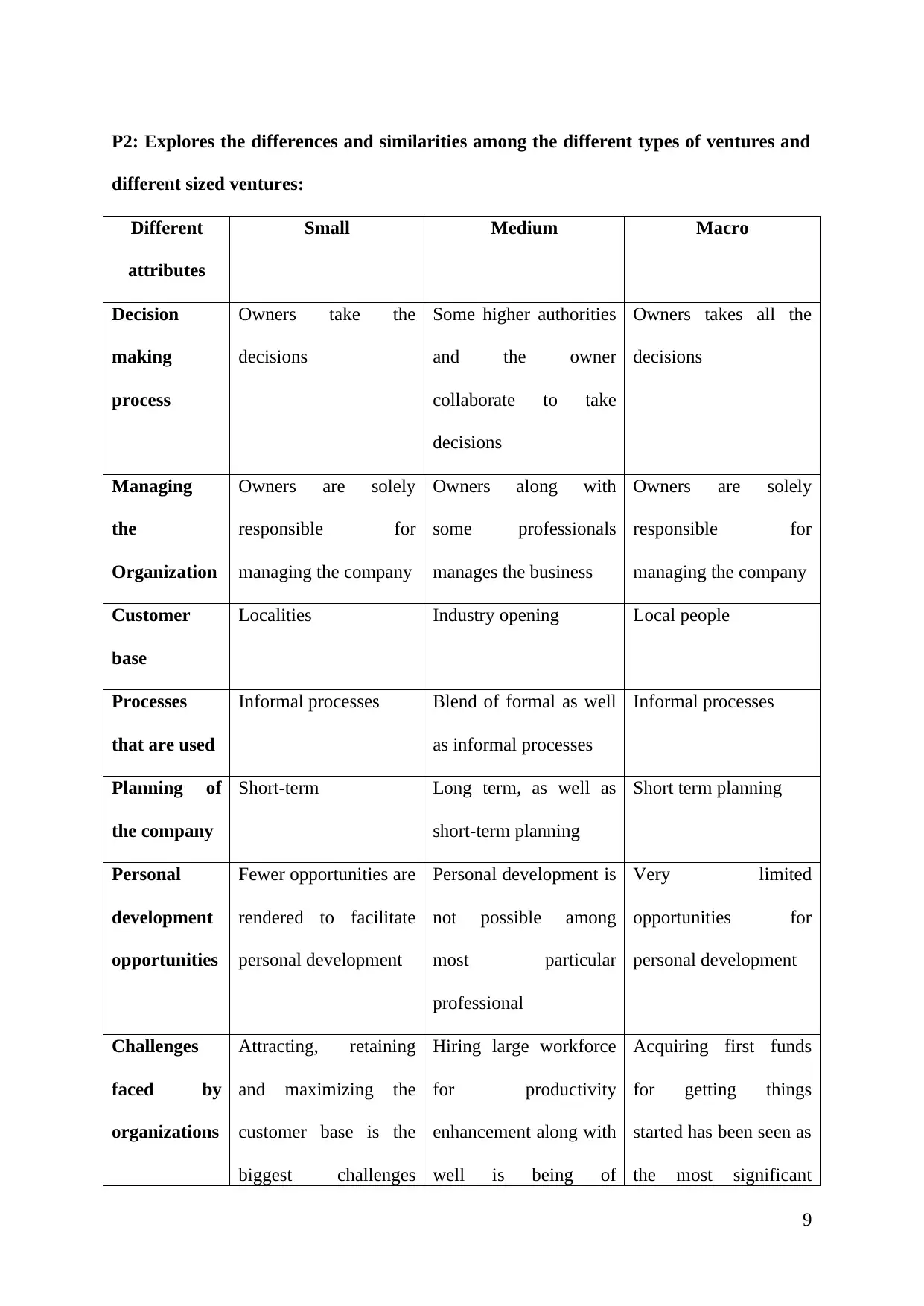
P2: Explores the differences and similarities among the different types of ventures and
different sized ventures:
Different
attributes
Small Medium Macro
Decision
making
process
Owners take the
decisions
Some higher authorities
and the owner
collaborate to take
decisions
Owners takes all the
decisions
Managing
the
Organization
Owners are solely
responsible for
managing the company
Owners along with
some professionals
manages the business
Owners are solely
responsible for
managing the company
Customer
base
Localities Industry opening Local people
Processes
that are used
Informal processes Blend of formal as well
as informal processes
Informal processes
Planning of
the company
Short-term Long term, as well as
short-term planning
Short term planning
Personal
development
opportunities
Fewer opportunities are
rendered to facilitate
personal development
Personal development is
not possible among
most particular
professional
Very limited
opportunities for
personal development
Challenges
faced by
organizations
Attracting, retaining
and maximizing the
customer base is the
biggest challenges
Hiring large workforce
for productivity
enhancement along with
well is being of
Acquiring first funds
for getting things
started has been seen as
the most significant
9
different sized ventures:
Different
attributes
Small Medium Macro
Decision
making
process
Owners take the
decisions
Some higher authorities
and the owner
collaborate to take
decisions
Owners takes all the
decisions
Managing
the
Organization
Owners are solely
responsible for
managing the company
Owners along with
some professionals
manages the business
Owners are solely
responsible for
managing the company
Customer
base
Localities Industry opening Local people
Processes
that are used
Informal processes Blend of formal as well
as informal processes
Informal processes
Planning of
the company
Short-term Long term, as well as
short-term planning
Short term planning
Personal
development
opportunities
Fewer opportunities are
rendered to facilitate
personal development
Personal development is
not possible among
most particular
professional
Very limited
opportunities for
personal development
Challenges
faced by
organizations
Attracting, retaining
and maximizing the
customer base is the
biggest challenges
Hiring large workforce
for productivity
enhancement along with
well is being of
Acquiring first funds
for getting things
started has been seen as
the most significant
9
⊘ This is a preview!⊘
Do you want full access?
Subscribe today to unlock all pages.

Trusted by 1+ million students worldwide

faced by small
business.
employees. hurdle coming in the
way.
Table 1: similarities and differences among the small, micro and medium-sized firm
(Source Farkas, 2015)
Different attributes Private venture Social ventures Public
undertakings
Value Corporate value Social value Social as well as
corporate value
Money sources Taking loans from
banks and issuing
debentures
Getting donations
from wealthy
foundations
Collecting money
from excise duty,
penalty, tax, etc
Profit distribution Distributed among
the investors or
shareholders
Shareholders and the
society gets
benefitted
Society and
shareholders both
are benefitted
Causes for strategy
development
Developing the
value of the market
share
Addressing the
social objectives are
the prima
Developing the
lifestyle of the
society
Main Aim Achieving huge
amount of profit
Delivering excellent
services to the
customers
Provision of the
more significant
amount of social
value
10
business.
employees. hurdle coming in the
way.
Table 1: similarities and differences among the small, micro and medium-sized firm
(Source Farkas, 2015)
Different attributes Private venture Social ventures Public
undertakings
Value Corporate value Social value Social as well as
corporate value
Money sources Taking loans from
banks and issuing
debentures
Getting donations
from wealthy
foundations
Collecting money
from excise duty,
penalty, tax, etc
Profit distribution Distributed among
the investors or
shareholders
Shareholders and the
society gets
benefitted
Society and
shareholders both
are benefitted
Causes for strategy
development
Developing the
value of the market
share
Addressing the
social objectives are
the prima
Developing the
lifestyle of the
society
Main Aim Achieving huge
amount of profit
Delivering excellent
services to the
customers
Provision of the
more significant
amount of social
value
10
Paraphrase This Document
Need a fresh take? Get an instant paraphrase of this document with our AI Paraphraser

Challenges faced Private
sectororganisation
mainly face
difficulties in
attaining the
tremendous amount
of benefit
Increasing their
income and raising
fund.
Providing adequate
services in the fiscal
downturn conditions
and effectively
manage the asset as
well as the
infrastructure of the
country
Table 1: similarities and differences among the small, micro and medium-sized firm
(Source:Eid, 2014)
The above explores the differences and similarities among the different types of ventures and
differently sized stakes.
11
sectororganisation
mainly face
difficulties in
attaining the
tremendous amount
of benefit
Increasing their
income and raising
fund.
Providing adequate
services in the fiscal
downturn conditions
and effectively
manage the asset as
well as the
infrastructure of the
country
Table 1: similarities and differences among the small, micro and medium-sized firm
(Source:Eid, 2014)
The above explores the differences and similarities among the different types of ventures and
differently sized stakes.
11
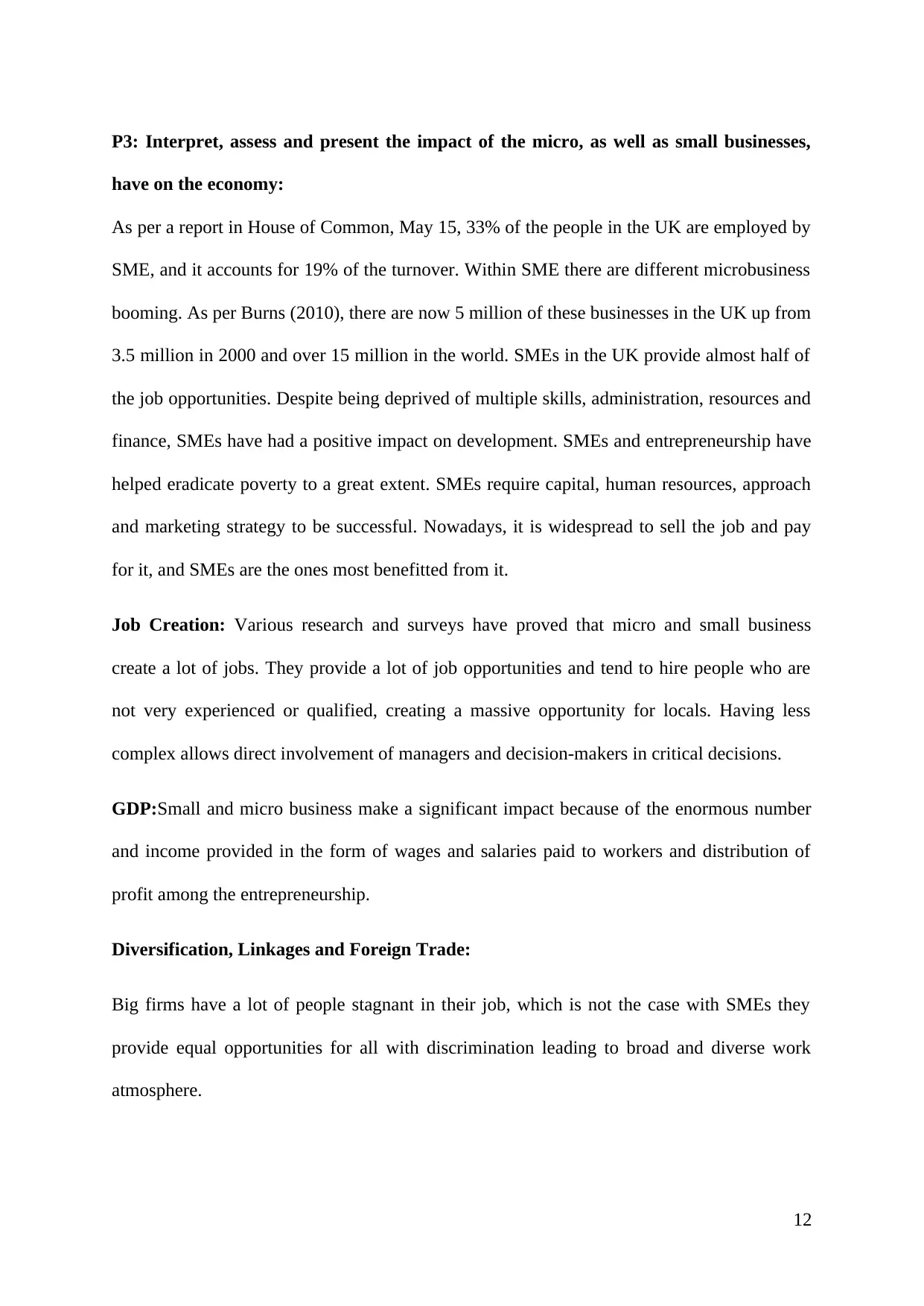
P3: Interpret, assess and present the impact of the micro, as well as small businesses,
have on the economy:
As per a report in House of Common, May 15, 33% of the people in the UK are employed by
SME, and it accounts for 19% of the turnover. Within SME there are different microbusiness
booming. As per Burns (2010), there are now 5 million of these businesses in the UK up from
3.5 million in 2000 and over 15 million in the world. SMEs in the UK provide almost half of
the job opportunities. Despite being deprived of multiple skills, administration, resources and
finance, SMEs have had a positive impact on development. SMEs and entrepreneurship have
helped eradicate poverty to a great extent. SMEs require capital, human resources, approach
and marketing strategy to be successful. Nowadays, it is widespread to sell the job and pay
for it, and SMEs are the ones most benefitted from it.
Job Creation: Various research and surveys have proved that micro and small business
create a lot of jobs. They provide a lot of job opportunities and tend to hire people who are
not very experienced or qualified, creating a massive opportunity for locals. Having less
complex allows direct involvement of managers and decision-makers in critical decisions.
GDP:Small and micro business make a significant impact because of the enormous number
and income provided in the form of wages and salaries paid to workers and distribution of
profit among the entrepreneurship.
Diversification, Linkages and Foreign Trade:
Big firms have a lot of people stagnant in their job, which is not the case with SMEs they
provide equal opportunities for all with discrimination leading to broad and diverse work
atmosphere.
12
have on the economy:
As per a report in House of Common, May 15, 33% of the people in the UK are employed by
SME, and it accounts for 19% of the turnover. Within SME there are different microbusiness
booming. As per Burns (2010), there are now 5 million of these businesses in the UK up from
3.5 million in 2000 and over 15 million in the world. SMEs in the UK provide almost half of
the job opportunities. Despite being deprived of multiple skills, administration, resources and
finance, SMEs have had a positive impact on development. SMEs and entrepreneurship have
helped eradicate poverty to a great extent. SMEs require capital, human resources, approach
and marketing strategy to be successful. Nowadays, it is widespread to sell the job and pay
for it, and SMEs are the ones most benefitted from it.
Job Creation: Various research and surveys have proved that micro and small business
create a lot of jobs. They provide a lot of job opportunities and tend to hire people who are
not very experienced or qualified, creating a massive opportunity for locals. Having less
complex allows direct involvement of managers and decision-makers in critical decisions.
GDP:Small and micro business make a significant impact because of the enormous number
and income provided in the form of wages and salaries paid to workers and distribution of
profit among the entrepreneurship.
Diversification, Linkages and Foreign Trade:
Big firms have a lot of people stagnant in their job, which is not the case with SMEs they
provide equal opportunities for all with discrimination leading to broad and diverse work
atmosphere.
12
⊘ This is a preview!⊘
Do you want full access?
Subscribe today to unlock all pages.

Trusted by 1+ million students worldwide
1 out of 22
Related Documents
Your All-in-One AI-Powered Toolkit for Academic Success.
+13062052269
info@desklib.com
Available 24*7 on WhatsApp / Email
![[object Object]](/_next/static/media/star-bottom.7253800d.svg)
Unlock your academic potential
Copyright © 2020–2025 A2Z Services. All Rights Reserved. Developed and managed by ZUCOL.



